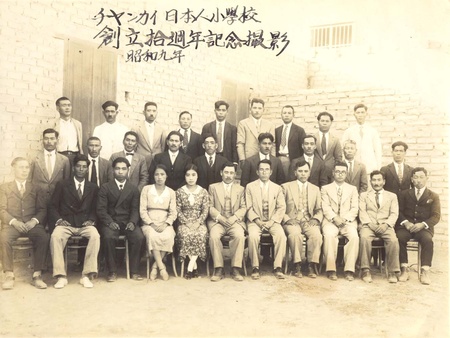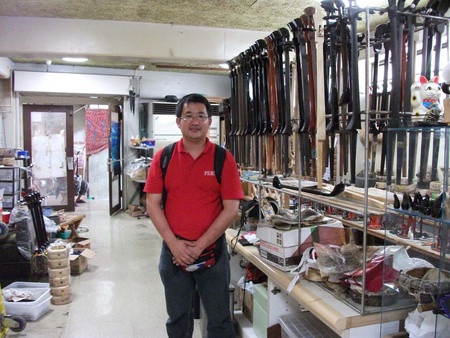Rubén Sugano loves talking to older people. Issei or nisei. Listen to their stories. Nurture yourself with them. It's a “vice,” he says. An addiction to stories that usually go back to war, to hard childhoods, to blows that shape strong personalities that overcome adversity.
The vice was born during his childhood. In Huaral, province of Lima where the 38-year-old musician and researcher grew up, his friends were his father's friends. His interest in the history of Japanese immigration to Peru grew in parallel.
At home he browsed through the objects of his grandfather born in Fukushima. Although his ojiichan died when Rubén was barely seven years old and he retains vague memories of him, his belongings have been a valuable inheritance. When he was a boy he opened his grandfather's Japanese books without understanding anything, but fascinated by the mysteries that their pages contained.

(Photos: Rubén Sugano's personal archive)
Where Rubén lived, there was once a Japanese school that was demolished. Some school objects ended up in his house (he doesn't know exactly why, perhaps his grandfather held a managerial position): furniture, documents, a blackboard, a clock, etc. Relics that also caught his attention and whose historical value he gradually became aware of.
Listening to Rubén is like watching a dealer in action: he distributes stories like someone who deals cards. “I'm interested in everything that came before us,” he says.
From his conversations with the elders he rescues, for example, stories about what the Japanese schools that the Nisei attended were like. His father told him that the children went to the school where he studied without shoes, and that they only used them when they received visitors.
When his father was a child and walked on the street, he had to manage to find routes that would prevent him from crossing paths with kids who harassed him for being the son of Japanese parents. If he ran into them, the next time he looked for a new path. It was as if there were mined areas in their neighborhood.
There was a lot of poverty. He asked a Nisei from Huaral why he didn't have photos of his childhood. “My dad was so poor that he couldn't even take photos of us,” he answered.
He has also collected souvenirs from World War II. An ojiichan who lived through the war in Okinawa told him that he was hiding from American soldiers in a well. As a child, he could shrink himself to the point of preventing enemies from discovering him when they looked into the well. At night he went out to look for food. One day, however, he was captured. It wasn't a misfortune. Quite the opposite. He remembers it as a happy day because he was able to drink milk and eat well.
In alliance with a group of friends, Rubén plans to spread these stories through conversations, especially among young people so that they know what their grandparents or great-grandparents experienced. “The kids today think that everything is easy: the ojiichan came, worked, made a fortune, how easy it was. "They don't know everything they went through."
A piece of advice he received one day from an older person made him think about how privileged he is to have had the opportunity to study, unlike the immigrants who came as laborers or many Nisei who had to abandon their studies to go to work and contribute to the support of the family: “Don't work like a donkey, use your head. It's easier for you, you have studies. "We didn't have studies."
20 YEARS WITH THE SANSHIN
When Rubén finished high school, his father sent him to Lima to pursue higher education. A year later, in 1996, he saw for the first time an instrument that he never suspected would become a fundamental part of his life: the sanshin. I didn't even know its existence. He thought it was strange and the matter did not go any further, but three years later, through friends, he began to touch it.
Accustomed since he was a child to seeing a story behind every person or object, his interest in this instrument originally from Okinawa extended beyond the musical. It was not enough for him to touch it, he also wanted to know how it came to Peru, how important it was for the immigrants. He had a sensei, Julio Heshiki, who guided him through the world of sanshin.
For Ruben, sanshin not only has history, but also life. Since 2003 he has been dedicated to repairing it and every time he does it he feels like he has resurrected it. When someone brings him one to repair, he thinks: “This sanshin has a history, a trajectory, we have to give it life again.”
He has made sanshin, but prefers to repair them. It's more exciting. When you receive one and find out that it belonged to a great master, your skin crawls. Think about how much history it holds and feel a great responsibility. He treats it as if it were a sacred object. With great respect.
He once repaired a sanshin that, he later learned from specialists, was 120 years old. He stayed cold. “If I had known, I wouldn't have touched it,” he jokes.
It started out of necessity and empirically: when any part of his sanshin broke, he looked for a way to fix it. He learned by screwing up.
“At first they brought me a sanshin and told me 'paint it', and I painted it. Then I realized what a stupid thing I had done, I killed the story. “You change the painting of the sanshin and take away its historical value.” Now he receives a sanshin with a crack and leaves it intact. It is also history.
Rubén learned a lot from a friend who, thanks to a scholarship in Okinawa, was trained in sanshin repair.
Now, one more step was missing in his personal history: teaching.
When he realized that there was a lot of misinformation about sanshin in Peru, he decided to make an instructional video. However, they convinced him to create something more ambitious: a documentary. The purpose was no longer only didactic, but also historical. In addition, it represented a great opportunity to remember and honor the teachers and promoters of sanshin. The documentary was released in 2012.
When did the first sanshin arrive in Peru? Under what circumstances?
The first Okinawan immigrants arrived in Peru in 1906. The first sanshin would have arrived in Peru in the middle of the following decade, according to a book on Okinawan music that he consulted. How did they “endure” without music for so many years? Rubén wonders (he emphasizes: where there is an Okinawan, there is always music and a sanshin). He believes that immigrants managed to construct sanshin with the materials they had available in Peru before the instrument arrived from Okinawa. One was even found on a farm made with a tin can and a broomstick. That's how great the need for music was.
Although Rubén has been a member of various bands, he has stepped away from the stage to focus on his work as a repairer and disseminator of sanshin (and his work as a business administrator).
Without a doubt, his is an authorized voice in Peru to speak about this historic Okinawan instrument. However, he prefers to be cautious: “To say that I know enough, I am missing a lot.”
NOW IT'S FUKUSHIMA
Rubén has strong ties with the community of Okinawan origin in Peru, where they welcomed him with open arms. In 2011 he traveled to Okinawa to participate in the Uchinanchu Taikai. "I went crazy. Since I like music and art, it seemed like paradise to me. “In Okinawa, art is a right, not a luxury.”
The importance that artistic manifestations have in Okinawa has made it possible for their descendants in Peru to maintain a close relationship with the land of their ancestors. There is no social glue stronger than music and dance. Nothing integrates more.
Rubén maintains that the scholarships that Okinawa offers to young people of Okinawan descent are essential to maintaining the umbilical cord, since these children return to Peru with teachings (sanshin, odori , etc.) that they share with other young people.
Now he plans a new trip to Okinawa to attend the Uchinanchu Taikai. This time, however, he wants to take the opportunity to visit the town of Fukushima where his grandfather lived. He also plans to visit Yokohama, where the ship that took him to Peru left. Rubén's goal is to reconstruct the itinerary that his grandfather followed 99 years ago to reach the other side of the Pacific. You already know the farms in Peru where he worked. Only Japan is missing.
Issei like your grandfather are a source of inspiration. When you ask him what stands out most about Japanese immigrants, he answers without hesitation: perseverance.
“My ojiichan , how many times he fell and how many times he got up,” he says. If you fall, raise your head. Rubén remembers that he once suffered a severe mental breakdown. However, thanks to the testimonies of older people, who told him how they stood up every time they suffered a setback, never giving up, he felt motivated to keep going. Furthermore, he noted that their drama was nothing compared to the terrible things they experienced, especially during the war.
As part of his work to disseminate the history of the Nikkei community, Rubén is preparing a documentary about the history of odori in Peru, through four sensei who narrate how they learned to dance and who their teachers were.
Anyway, there is a lot of history to tell about Japanese immigrants and their descendants in Peru. Of course, Rubén says that the story must be told without censorship, regardless of what they will say, without sugarcoating it. The true story.
© 2016 Enrique Higa







